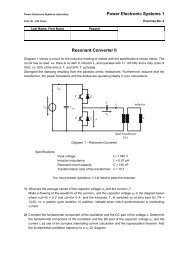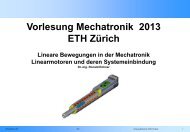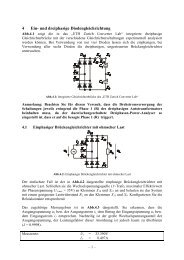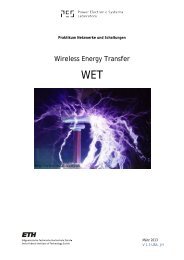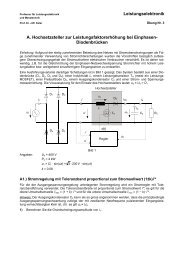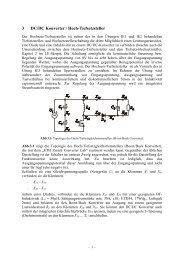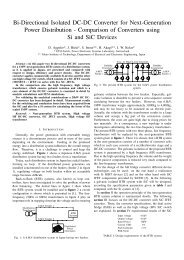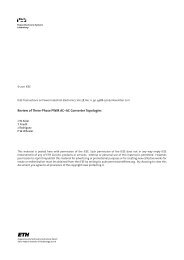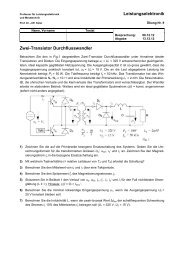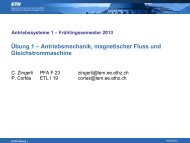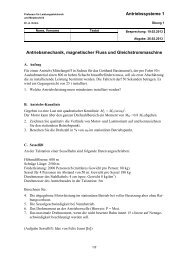U. Badstübner, J. Biela, J. W. Kolar, Power Density and Efficiency ...
U. Badstübner, J. Biela, J. W. Kolar, Power Density and Efficiency ...
U. Badstübner, J. Biela, J. W. Kolar, Power Density and Efficiency ...
You also want an ePaper? Increase the reach of your titles
YUMPU automatically turns print PDFs into web optimized ePapers that Google loves.
ZVS/ZCS condition only allows to reduce the number of<br />
topologies to a few promising ones. For a more detailed comparison<br />
identifying the most suitable topology, an optimization<br />
of each topology with respect to the considered comparison<br />
criteria, power density <strong>and</strong> efficiency, is required.<br />
Therefore, a comparison of different DC-DC converters<br />
topologies based on an optimization procedure with comprehensive<br />
analytical models is presented in this paper. The<br />
most suitable topologies for high power telecom converters<br />
are the series-parallel resonant converter (schematic <strong>and</strong> the<br />
constructed hardware based on the optimization procedure are<br />
shown in Fig. 1) <strong>and</strong> the phase-shift PWM converter (cf.<br />
Fig. 2), which both allow soft-switching. For these two<br />
converters different output stages (LC-filter, C-filter with mid<br />
point connection <strong>and</strong> current doubler) are possible <strong>and</strong> have<br />
been investigated [12].<br />
A short survey on applicable topologies <strong>and</strong> an evaluation,<br />
based on the mentioned criteria with respect to the achievable<br />
power density <strong>and</strong> efficiency, is given in in Section II. There,<br />
also the operation of the phase-shift <strong>and</strong> the series-parallel<br />
resonant converter including the digital control using a state<br />
machine is shortly explained. For the topology comparison<br />
a comprehensive optimization procedure is required, which<br />
is presented in Section III with the corresponding different<br />
analytical models for the converters such as the HF transformer<br />
losses <strong>and</strong> the temperature distribution.<br />
With the presented optimization procedure the two topologies<br />
have been optimized, once for power density <strong>and</strong> once<br />
for maximum efficiency. The corresponding results of the<br />
optimization <strong>and</strong> a comparison of both converter topologies are<br />
discussed in Section IV. In the same section a validation of the<br />
resulting optimized parameters based on a circuit simulation is<br />
given. For validating the results a prototype <strong>and</strong> measurement<br />
results of an optimized series-parallel resonant converter are<br />
presented in Section V. There, also the design of a phase-shift<br />
converter with current doubler <strong>and</strong> the comparison between<br />
copper <strong>and</strong> aluminum heat sinks is given.<br />
II. CONVERTER TOPOLOGIES FOR IT APPLICATIONS<br />
In the area of low power converters often flyback <strong>and</strong><br />
single switch forward converters are applied. These topologies<br />
are not suitable if high output power with high efficiency<br />
is required. Enhanced <strong>and</strong>/or other topologies proposed for<br />
telecom supplies are, for example, the double interleaved forward<br />
converter [4], [13], the asymmetrical half bridge [5] <strong>and</strong><br />
multiresonant topologies [7]. However, these topologies do<br />
not fit the requirements concerning efficiency <strong>and</strong> high power<br />
density in the same way as full bridge topologies, operating<br />
with soft switching, due to the amount of semiconductors<br />
<strong>and</strong> passive components <strong>and</strong>/or the utilization of the duty<br />
cycle in half brides which results in larger transformers. In<br />
addition, the switching <strong>and</strong> conduction losses in asymmetrical<br />
half bridges increase <strong>and</strong> the efficiency decreases due to the<br />
asymmetrical current waveforms at high input voltages [6].<br />
As already mentioned in section I, the series-parallel resonant<br />
(cf. Fig. 1 bottom) <strong>and</strong> the phase-shift PWM fullbridge<br />
DC-DC converter (cf. Fig. 2) are well applicable for<br />
the considered telecom application. Both converters operates<br />
+<br />
VIN<br />
-<br />
C IN<br />
s11 s 12<br />
A<br />
s 21<br />
I P<br />
B<br />
s22<br />
V AB<br />
L σ<br />
N P<br />
a) Current doubler<br />
N S<br />
NS<br />
2N S<br />
b) C-filter<br />
L S1<br />
C OUT<br />
+<br />
V OUT<br />
LS2<br />
I OUT<br />
I OUT<br />
C OUT<br />
+<br />
Figure 2: Schematic of a phase-shift DC-DC converter with a)<br />
current doubler or b) center-tapped transformer with LC-filter.<br />
with soft-switching <strong>and</strong> enable high efficiency at higher output<br />
power levels. In addition, full-bridge converters better utilize<br />
the transformer due to the bipolar flux swing. Therefore, a<br />
smaller transformer size <strong>and</strong> weight can be achieved.<br />
A. Phase-Shift PWM DC-DC Converter<br />
When operating a conventional PWM full bridge at high<br />
power <strong>and</strong> high frequency, the converter performance will be<br />
reduced by the switching losses due to the circuit parasitics. A<br />
specially-operating mode of the PWM full bridge, allows all<br />
switching devices (cf. Fig. 2) to operate under zero voltage<br />
(ZVS) condition (e.g. in [2], [11]). There, the parasitics of the<br />
circuit are advantageously used to achieve the soft-switching<br />
condition.<br />
In Fig. 2 two possible output stages are shown: a mid<br />
point connection with C-filter (CTC) <strong>and</strong> the current doubler<br />
(CDR). Both topologies enable a compact construction with<br />
high efficiency <strong>and</strong> will be considered in the optimization.<br />
In Fig. 3 the control scheme <strong>and</strong> the principle voltage/current<br />
waveforms of the phase-shifted PWM converter<br />
are given. There, the power flow is controlled by the<br />
phase-shift between the two legs, which also determines<br />
the duty cycle of the converter. The switching of all four<br />
IGBTs/MOSFETs is performed under ZVS condition by using<br />
the energy stored in the leakage inductance (L σ , cf. Fig. 2),<br />
in order to charge/discharge the parasitic output capacitances<br />
of both switches in the switching leg. Further details can be<br />
found in literature mentioned above.<br />
B. Series-Parallel Resonant DC-DC Converter<br />
The series-parallel resonant converter is a combination of a<br />
series <strong>and</strong> a parallel resonant DC-DC converter, as shown in<br />
Fig. 1. With a proper choice of the resonant tank components<br />
values (C S , L S <strong>and</strong> C P ), the series-parallel resonant converter<br />
combines the advantages of the series resonant converter:<br />
• Series capacitor C S blocks the DC voltage, thus avoiding<br />
the transformers saturation<br />
• The partial load efficiency is high due to the decrease in<br />
device currents with a decrease in load<br />
<strong>and</strong> the advantages of the parallel resonant converter:<br />
• Controlled operation at light load<br />
VOUT<br />
-



